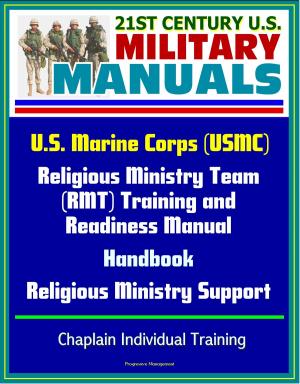Aftermath: A Historical Analysis of Resiliency Following Failure in Battle – Four Aerial Battles Where U.S. Airmen Won after Failure in World War I and II, Korea, and Vietnam, Esprit de Corps
Nonfiction, History, Military, Vietnam War, Asian, Aviation| Author: | Progressive Management | ISBN: | 9781370048656 |
| Publisher: | Progressive Management | Publication: | March 2, 2017 |
| Imprint: | Smashwords Edition | Language: | English |
| Author: | Progressive Management |
| ISBN: | 9781370048656 |
| Publisher: | Progressive Management |
| Publication: | March 2, 2017 |
| Imprint: | Smashwords Edition |
| Language: | English |
This excellent report has been professionally converted for accurate flowing-text e-book format reproduction. This monograph set out to determine if the USAF exhibited enduring organizational resiliency traits by analyzing four aerial battles where US airmen recovered from initial failure and achieved subsequent victory. The author used literary works from the field of military defeat to determine the framework to evaluate the selected World War I, World War II, Korea, and Vietnam battles. This paper concluded that there were four enduring characteristics that made airmen and their organizations resilient.
First, strategic reserves and industrial capacity were vital to an organization's ability to replace its losses and return to full strength. World War I highlighted the dangers of failing to prepare the country for mass-mobilized, industrial warfare. These lessons led to the industrial base that allowed Eighth Air Force to recover from staggering losses in the opening months of the Combined Bomber Offensive. The advent of the Cold War resulted in a large active duty air force plus a sizeable reserve and National Guard component, a surplus of aircraft in long-term storage, a strategic industrial reserve capacity, and stockpiles of strategic and critical materials, allowing the USAF to overcome losses sustained in the Korean War. However, the Vietnam War highlighted that if the Air National Guard and Air Force Reserve are not used as intended, they cannot strengthen the resiliency of the USAF and its combat units.
Second, combat experience and flexibility were critical factors in reducing casualties and helping an organization recover from its losses. Veteran airmen possessed knowledge that could only be learned by years of study, training, exercising, and fighting. Using a 'combat orientation' program, they passed valuable experience to new aircrews while mitigating the extremely high risks associated with the first days of combat. Additionally, veterans helped units adjust tactics and upgrade aircraft and aircraft systems in order to counter the enemy advantages and prevent subsequent defeat.
Third, esprit de corps was vital to a unit's ability to recover from failure. Psychological and cultural beliefs such as confidence, honor, and loyalty caused airmen to engage the enemy continually despite the understanding that they and their brethren were likely to become casualties. Additionally, the ability to grieve and then compartmentalize allowed pilots to accomplish their mission.
Fourth, leadership at all levels, from the strategic to the tactical, influenced the resilience of an organization. Strategic and operational leaders made decisions and implemented policies that had long-term impact on a unit's resiliency. At the tactical level, formal and informal leaders influenced the organization's short-term recovery process by addressing esprit de corps problems, correcting tactical deficiencies, exhibiting courage in the face of the enemy, mentoring new pilots, and helping the squadron grieve lost comrades. Lastly, this paper proposes several situations that highlight potential resiliency shortfalls in the current force and require further evaluation.
This excellent report has been professionally converted for accurate flowing-text e-book format reproduction. This monograph set out to determine if the USAF exhibited enduring organizational resiliency traits by analyzing four aerial battles where US airmen recovered from initial failure and achieved subsequent victory. The author used literary works from the field of military defeat to determine the framework to evaluate the selected World War I, World War II, Korea, and Vietnam battles. This paper concluded that there were four enduring characteristics that made airmen and their organizations resilient.
First, strategic reserves and industrial capacity were vital to an organization's ability to replace its losses and return to full strength. World War I highlighted the dangers of failing to prepare the country for mass-mobilized, industrial warfare. These lessons led to the industrial base that allowed Eighth Air Force to recover from staggering losses in the opening months of the Combined Bomber Offensive. The advent of the Cold War resulted in a large active duty air force plus a sizeable reserve and National Guard component, a surplus of aircraft in long-term storage, a strategic industrial reserve capacity, and stockpiles of strategic and critical materials, allowing the USAF to overcome losses sustained in the Korean War. However, the Vietnam War highlighted that if the Air National Guard and Air Force Reserve are not used as intended, they cannot strengthen the resiliency of the USAF and its combat units.
Second, combat experience and flexibility were critical factors in reducing casualties and helping an organization recover from its losses. Veteran airmen possessed knowledge that could only be learned by years of study, training, exercising, and fighting. Using a 'combat orientation' program, they passed valuable experience to new aircrews while mitigating the extremely high risks associated with the first days of combat. Additionally, veterans helped units adjust tactics and upgrade aircraft and aircraft systems in order to counter the enemy advantages and prevent subsequent defeat.
Third, esprit de corps was vital to a unit's ability to recover from failure. Psychological and cultural beliefs such as confidence, honor, and loyalty caused airmen to engage the enemy continually despite the understanding that they and their brethren were likely to become casualties. Additionally, the ability to grieve and then compartmentalize allowed pilots to accomplish their mission.
Fourth, leadership at all levels, from the strategic to the tactical, influenced the resilience of an organization. Strategic and operational leaders made decisions and implemented policies that had long-term impact on a unit's resiliency. At the tactical level, formal and informal leaders influenced the organization's short-term recovery process by addressing esprit de corps problems, correcting tactical deficiencies, exhibiting courage in the face of the enemy, mentoring new pilots, and helping the squadron grieve lost comrades. Lastly, this paper proposes several situations that highlight potential resiliency shortfalls in the current force and require further evaluation.















